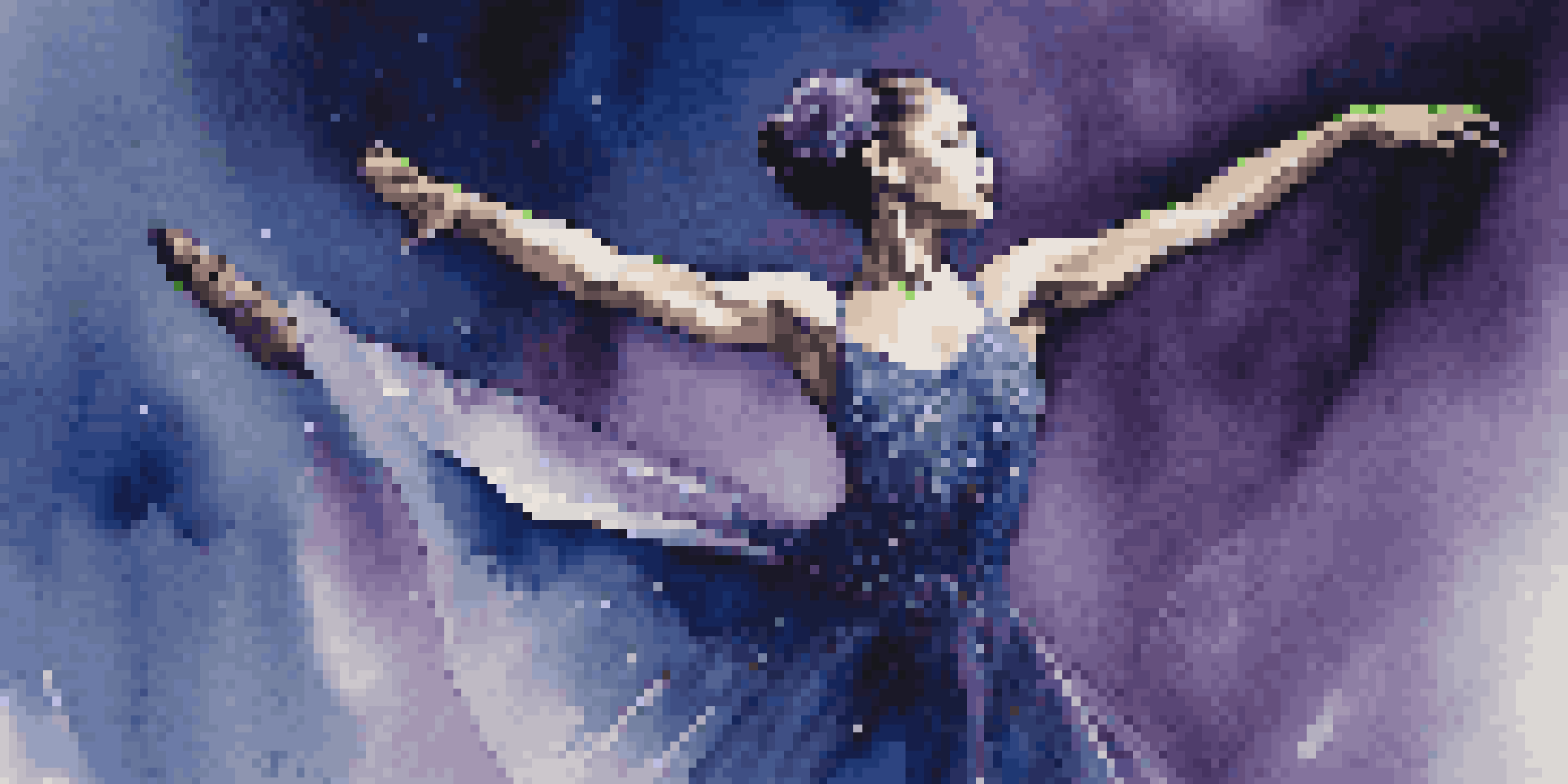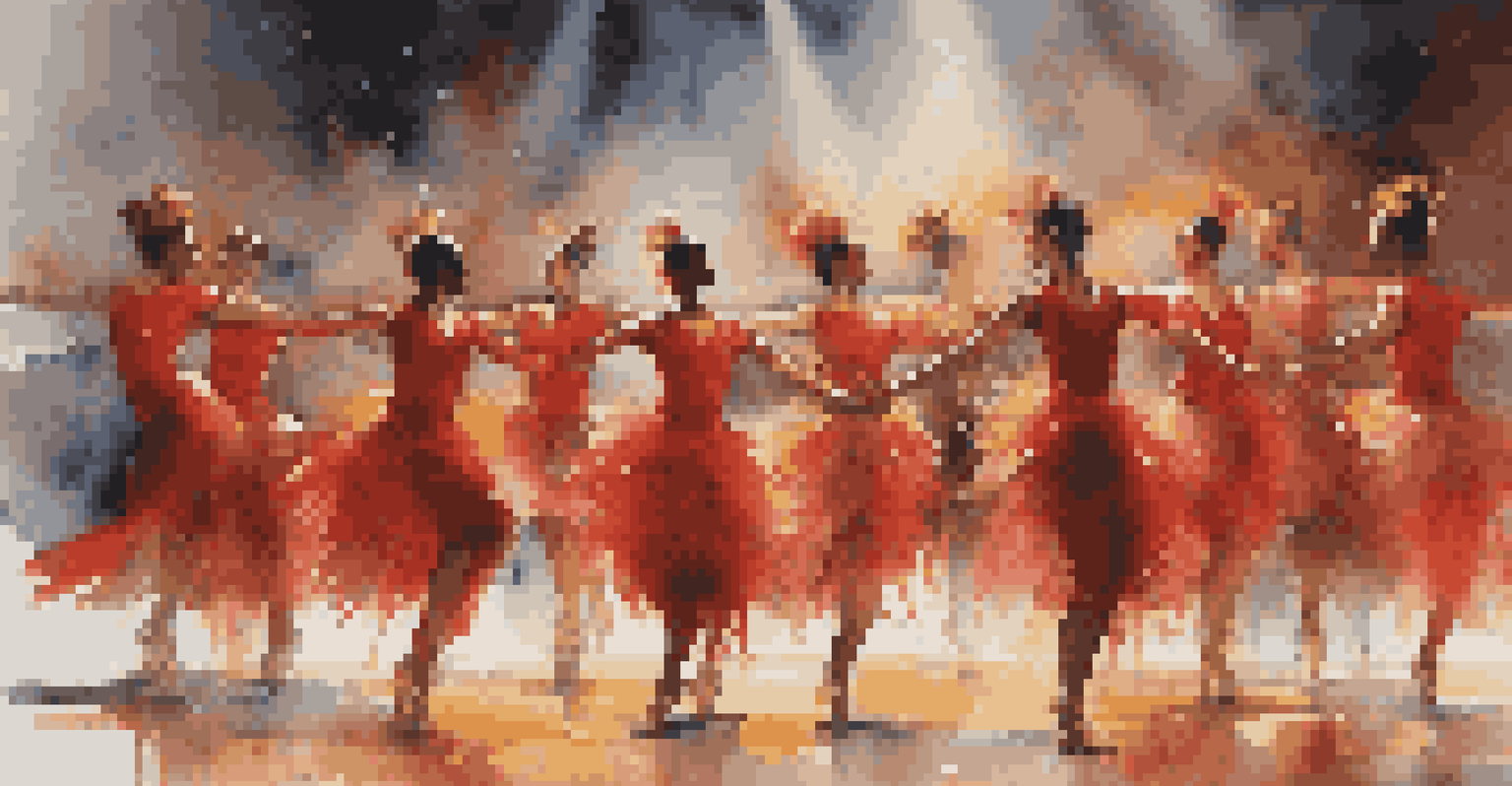The Influence of Dance Competitions on Emotional Expression

Understanding Dance Competitions and Emotional Expression
Dance competitions are more than just a showcase of talent; they are a platform where dancers express their emotions through movement. Each performance tells a story, reflecting the dancer's inner feelings and experiences. This unique combination of competition and artistry creates an environment rich in emotional expression.
Dance is the hidden language of the soul.
During competitions, dancers often tap into deep emotions, whether it's joy, sadness, or passion. The pressure to perform can intensify these feelings, leading to powerful, memorable performances. For many, this emotional release is not only cathartic but also a vital part of their artistic journey.
Furthermore, the audience's reaction can amplify emotional expression. When viewers connect with a dancer's performance, it creates a shared experience that resonates on a deeper level. This interaction highlights the incredible power of dance as a universal language of emotions.
How Competition Formats Influence Emotional Expression
Different formats of dance competitions can significantly influence how dancers express their emotions. For example, solo performances allow for a personal exploration of emotions, while group routines may emphasize collective feelings and teamwork. Each format presents unique opportunities for emotional storytelling.

In solo competitions, dancers often draw from their personal experiences, leading to raw and authentic performances. Conversely, in group settings, the synergy between dancers can create a dynamic emotional landscape that reflects shared experiences. This interplay can enhance the overall impact of the performance.
Emotional Expression Through Dance
Dance competitions serve as a powerful platform for dancers to express their emotions, allowing each performance to tell a unique story.
Moreover, judges and audience members play a critical role in this emotional expression. Their feedback and reactions can motivate dancers to push their emotional boundaries and connect with their audience on a more profound level. This feedback loop fosters an environment where emotional expression thrives.
The Role of Preparation in Emotional Expression
Preparation is key to unlocking emotional expression in dance competitions. Dancers spend countless hours rehearsing not just the technical aspects of their routines but also the emotional nuances. This preparation allows them to channel their feelings effectively during performances.
The dance is a poem of which each movement is a word.
Choreographers often encourage dancers to explore their emotions during the creative process. By understanding the story behind the dance, performers can deliver a more authentic portrayal of their feelings. This deep connection to the material results in a compelling performance that resonates with the audience.
Additionally, mental preparation, such as visualization techniques or mindfulness practices, can enhance emotional expression. Dancers who engage in these practices often find themselves more in tune with their emotions, allowing for a richer performance experience. This holistic approach emphasizes the integration of mind and body in emotional expression.
The Impact of Audience Engagement on Emotional Expression
Audience engagement plays a crucial role in shaping emotional expression during dance competitions. Dancers often feed off the energy of the crowd, using their reactions to elevate their performance. When the audience is fully present and engaged, it creates a vibrant atmosphere that enhances emotional expression.
A supportive audience can provide a safe space for dancers to express their emotions freely. When viewers react positively, it encourages performers to take risks and delve deeper into their emotional portrayal. This mutual connection elevates the entire experience, transforming a competition into a shared journey of expression.
Impact of Audience Engagement
The energy and engagement of the audience significantly influence dancers' emotional expression, creating a vibrant atmosphere that enhances performances.
On the flip side, a disengaged audience can hinder emotional expression. If dancers sense indifference, it may lead to a more subdued performance. This highlights the importance of audience participation in dance competitions, as emotional expression thrives in environments where connection is fostered.
Judging Criteria and Its Effect on Emotional Expression
Judging criteria in dance competitions can influence how dancers approach emotional expression. Different competitions prioritize various elements, such as technique, choreography, and emotional delivery. Understanding these criteria can help dancers tailor their performances to meet expectations while still staying true to their emotions.
Some judges may place a higher value on emotional connection, encouraging dancers to focus on storytelling through movement. This emphasis can lead to more profound emotional expressions, as dancers strive to connect with both the judges and the audience. It fosters a competitive environment where emotional portrayal is just as important as technical skill.
However, rigid judging criteria can sometimes stifle creativity and emotional expression. Dancers may feel pressured to conform to specific standards, potentially leading to performances that lack authenticity. This balance between meeting expectations and embracing personal expression is a constant challenge in the competitive dance world.
The Therapeutic Benefits of Dance Competitions
Dance competitions can serve as a form of therapy, offering emotional release and personal growth. For many dancers, the act of performing allows them to express feelings that might be difficult to verbalize. This therapeutic aspect can be incredibly beneficial for emotional well-being.
Moreover, engaging in dance competitions can build resilience. Dancers learn to cope with the pressures of performance, handle criticism, and embrace vulnerability. These experiences contribute to personal development, fostering emotional intelligence and self-awareness.
Therapeutic Benefits of Competitions
Participating in dance competitions can provide emotional release and foster personal growth, contributing to dancers' emotional well-being and resilience.
Additionally, the supportive community often found in dance environments can provide a sense of belonging. This camaraderie helps dancers navigate their emotions together, reinforcing the idea that they are not alone in their experiences. The therapeutic benefits of dance competitions extend beyond the stage, impacting participants' lives in meaningful ways.
Future Trends in Dance Competitions and Emotional Expression
As dance competitions evolve, so too does the approach to emotional expression. Emerging trends, such as incorporating technology and multimedia elements, are changing how emotions are conveyed through dance. These innovations can enhance storytelling and emotional depth in performances.
Furthermore, there is a growing recognition of the importance of mental health in the dance community. Competitions are increasingly focusing on fostering a supportive environment that prioritizes emotional well-being. This shift encourages dancers to express their feelings authentically without the fear of judgment.

As we look to the future, we can expect dance competitions to continue embracing the emotional aspect of performance. With a greater emphasis on personal stories and emotional connection, the landscape of competitive dance will likely become even more vibrant and expressive, showcasing the true power of dance as a medium for emotional expression.